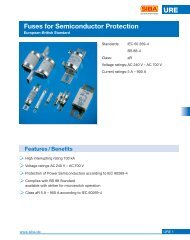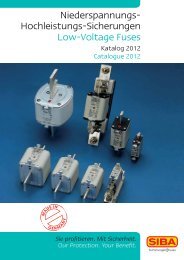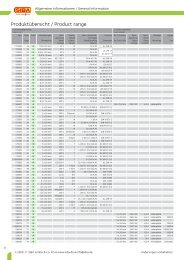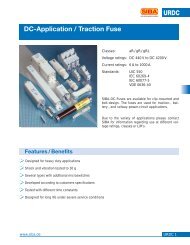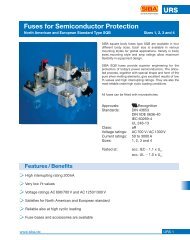magazine article - SIBA - Fuses
magazine article - SIBA - Fuses
magazine article - SIBA - Fuses
Create successful ePaper yourself
Turn your PDF publications into a flip-book with our unique Google optimized e-Paper software.
By<br />
Heinz-Ulrich Haas<br />
Head of R & D<br />
<strong>SIBA</strong> GmbH & Co KG<br />
fuse.on page 2<br />
SMD <strong>Fuses</strong> for<br />
“real” short circuits<br />
A new design which is able to interrupt 4000 A<br />
Our Protection.<br />
Your Benefi t.<br />
2010/01<br />
Compared with the established SMD fuses the new <strong>SIBA</strong> SMD fuses presented here appear quite<br />
large, even huge. The requirements for these components, however, are also huge: after all, they<br />
are intended to interrupt short-circuit currents of several hundred amperes and, in cases of faults,<br />
to isolate defective components or devices from the mains. How and why this works is described in<br />
this <strong>article</strong>. [1]<br />
The whole family<br />
Surface-mount fuses, i.e. SMD fuses, are used when it comes to monitoring and interrupting<br />
overcurrents on as small a space as possible. In order to achieve this, various constructions which<br />
make optimum use of the space available on a printed circuit board exist for the most diverse applications.<br />
Table 1 gives an overview of the most commonly used SMD fuses from the collection<br />
of types offered worldwide.<br />
Table 1: Overview of SMD <strong>Fuses</strong><br />
Fuse type Sizes Characteristic Rated voltage Rated current Breaking capacity<br />
Chip-type SMD 0402 to 1206 FF 32 to 63 V 250 mA to 5 A 50 A<br />
Block-type SMD 2,6 x 6,1 mm F and T 125 V 62 mA to 15 A 50 A<br />
Block-type SMD 4,5 x 8 mm F and T 250 V 32 mA to 6,3 A 100 A<br />
cylindrical SMD 5 x 20 mm F and T 250 V 1 to 6,3 A 1500 A<br />
The smallest members of the SMD fuse family are the chip-type ones (Figure 1a). With widths of,<br />
e.g., less than 1 mm they are used in mobile phones, shavers and other small appliances. They serve<br />
as “saving anchors” in cases of faults in the lithium battery. Typical voltage classes are 10 V, 20 V,<br />
30 V or 40 V, partly for AC and partly for DC operation.<br />
<strong>Fuses</strong> for operating voltages of 100 V and more are slightly larger. Being designed as SMD block types<br />
(Figure 1b), in most cases they have a ceramic housing and, in comparison with the chip-type fuses,<br />
they are “hard to miss”, having an edge dimension of, e.g., 6 mm. This group comprises also fuses<br />
with a rated voltage of 250 V. Thanks to a maximum breaking capacity of 100 A at 250 V they are<br />
able to provide short-circuit protection in secondary circuits.<br />
As far as protection in cases of “real” short circuits of some hundred amperes is concerned, so<br />
far, specially prepared cylindrical fuses with dimensions of 5 mm × 20 mm (Figure 1c) for surface<br />
mounting have been available. As compared with the standard design, the temperature stability<br />
required for the refl ow soldering process is ensured by means of the solder in the fuse melting at



